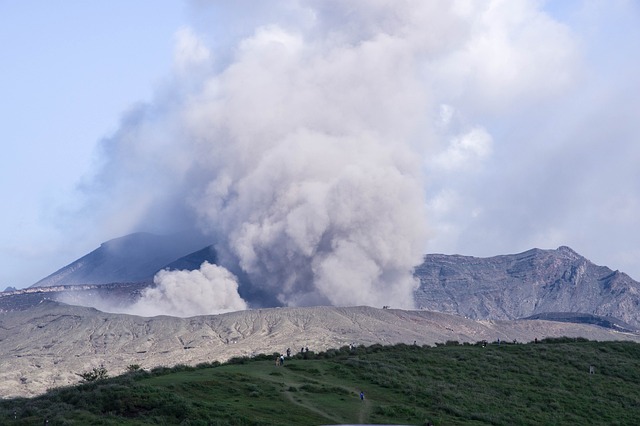The slumbering giant, Mount Adams, Washington’s largest volcano, has stirred from its long sleep. This colossal, snow-capped peak, the second tallest mountain in the state, hasn’t erupted since the Bronze Age, a time when humanity was just beginning to etch its mark on history. However, in recent months, a series of unusual rumblings have emerged from its depths, sending ripples of apprehension through the scientific community and raising concerns about a potential eruption.
It’s not uncommon for volcanoes, even those considered dormant, to exhibit signs of restlessness. The Earth’s crust is a dynamic entity, constantly shifting and adjusting. These movements, particularly near volcanic regions, can trigger seismic activity, releasing energy as tremors that can be detected by sensitive instruments. But the recent activity at Mount Adams is anything but ordinary. It’s a stark deviation from the usual, peaceful slumber of the “forgotten giant,” as it’s sometimes called, and has prompted a flurry of activity among geologists.
[ez-toc]
The Unsettling Tremors
In September, the United States Geological Survey (USGS), the country’s leading scientific agency for studying natural hazards, detected a disconcerting six earthquakes emanating from Mount Adams. This was an alarming number, considering that the volcano typically experiences only one or two tremors every two or three years. The last time such an intense concentration of seismic activity was recorded within a single month was in 1982, a year that stands out as a significant data point in the volcano’s history.
This spike in seismic activity immediately prompted the USGS to deploy additional sensors around the mountain, eager to gain a clearer picture of what was unfolding beneath the surface. The tremors themselves were relatively minor, with none exceeding a magnitude of 2.0 on the Richter scale. These were not the kind of earth-shaking events that would send shockwaves through the surrounding communities, and they were only detected by the sensitive instruments positioned seven miles away from the mountain’s summit.
Yet, even these seemingly insignificant tremors were enough to stir unease among those familiar with the unpredictable nature of volcanoes. While the events might appear innocuous at first glance, they serve as a stark reminder of the latent power residing within these geological marvels. The question on everyone’s mind is: are these tremors merely a fleeting whisper of the volcano’s natural restlessness, or are they the prelude to a more momentous event?
The Volcano’s Voice: A Symphony of Signals
Volcanoes, much like complex organisms, communicate their state of being through a myriad of signals, some subtle, others more pronounced. Seismic activity, while a crucial indicator, is merely one piece of the puzzle. Other factors, such as changes in gas emissions, ground deformation, and thermal anomalies, contribute to a comprehensive understanding of a volcano’s condition.
Imagine the volcano as a complex orchestra, where each instrument represents a distinct parameter. The seismic activity, like the drums, provides the rhythmic pulse, but the entire orchestra is needed to fully appreciate the symphony. While the drums may be pounding a bit faster than usual, a trained ear can detect subtle changes in the other instruments that might hint at a shift in the overall melody. The USGS, akin to a conductor, is meticulously analyzing every instrument, searching for any deviation that might signal a change in the volcano’s musical score.
The Volcano’s “Talking”
Despite the heightened activity, the USGS, in a reassuring statement, emphasized that there is no immediate cause for alarm. The agency employs a four-tiered alert system for volcanoes, with “normal” being the lowest level, indicating that the volcano is in a “typical background, noneruptive state.” At this point, Mount Adams remains firmly at the “normal” level, but the agency, like any cautious parent, is closely monitoring the situation, prepared to adjust the alert level if necessary.
Jon Major, the scientist-in-charge at the USGS’ Cascades Volcano Observatory, likened the situation to a volcano “talking to us a bit more than it normally does.” He emphasized that gathering more data is crucial to determine if this is merely an unusual burst of seismic activity or a sign of something more significant.
To gain a clearer understanding of these unsettling tremors, the USGS has received permission from the U.S. Forest Service to install additional, temporary seismic monitoring stations in the vicinity of Mount Adams. These stations will act as extra ears, listening intently to the whispers of the volcano, providing valuable insights into the nature and origin of the tremors.
The data gathered by these new sensors will be meticulously analyzed by the USGS, a task akin to deciphering a complex language. The scientists will meticulously compare the new readings to historical data, seeking any patterns, anomalies, or correlations that might provide clues to the causes of the seismic activity. This process is akin to a detective diligently examining every piece of evidence, leaving no stone unturned in their quest for the truth.
We also Published
- Questioning Common Medical Practices: More Harm Than Good?
Questioning Common Medical Practices: such as how common medical practices like thickening liquids for dementia patients and stopping blood pressure medications before surgery may not be as beneficial as previously thought. Explore the conflicting evidence surrounding spinal cord stimulators for chronic pain. - Additive Inverse of an Element: Understanding the Concept
Learn about the additive inverse of an element, how to find it, and its importance in mathematics. - The Root System in Plants – A Detailed Analysis
Explore the comprehensive details of the root system in plants, essential for plant biology.
A Giant’s Past and Potential Future
Despite its slumbering state, Mount Adams isn’t a sleeping beauty in a dormant state. This is a giant of immense power, classified by the USGS as a “high-threat volcano.” This classification isn’t a measure of the likelihood of an eruption, but rather a reflection of the potential impact of such an event.
The USGS recognizes the potential consequences of an eruption at Mount Adams, considering its proximity to populated areas, transportation networks, and critical infrastructure. The threat posed by a Mount Adams eruption isn’t simply a matter of volcanic ash raining down on the landscape; it’s a multi-faceted risk that could disrupt lives and economies.
The USGS is not merely watching for signs of an eruption, but also meticulously mapping out potential scenarios, analyzing historical data, and developing strategies to mitigate the risks. This is a crucial task, requiring a blend of scientific expertise, risk assessment, and a deep understanding of the volcano’s history and behavior.
Past Echoes of a Giant’s Fury: A Look Back in Time
Mount Adams, despite its long period of dormancy, has a history of fiery outbursts. The last eruption, dating back to the Bronze Age, is a testament to the immense power residing within this seemingly peaceful mountain. While this eruption happened thousands of years ago, it’s a reminder that the volcano is capable of unleashing its destructive force.
Geologists have meticulously studied the evidence of past eruptions, analyzing volcanic rock, ash deposits, and other geological remnants to piece together a narrative of Mount Adams’ past. This is akin to reading a long-forgotten book, each chapter unveiling another fragment of the volcano’s history.
The Nature of the Beast: An Analysis of Past Eruptions
Past eruptions of Mount Adams haven’t been characterized by the explosive violence of some of its counterparts, like Mount St. Helens. Mount Adams’ eruptions have been more subdued, characterized by lava flows that have traveled only a few miles from the volcanic vent. While these lava flows might not seem as dramatic as the towering ash columns that can accompany more explosive eruptions, they can still pose a significant threat to infrastructure and wildlife.
The USGS, with its meticulous analysis of past eruptions, is not only piecing together the volcano’s history but also building a roadmap of its potential future. This historical data provides a framework for understanding the volcano’s behavior, allowing scientists to predict potential eruption scenarios with a greater degree of accuracy.
The Shadow of St. Helens: A Cautionary Tale
The eruption of Mount St. Helens in 1980, a cataclysmic event that claimed 57 lives, is a sobering reminder of the devastating potential of volcanoes. It’s a pivotal moment in geological history, a stark reminder of the raw power residing within the earth. It also served as a catalyst for advancements in volcano monitoring and hazard assessment.
The eruption of Mount St. Helens, while devastating, provided valuable insights into the complex workings of volcanoes. It spurred advancements in monitoring technologies, risk assessment methodologies, and communication strategies, all of which have contributed to a greater understanding of volcanic hazards.
The events of 1980 are a stark reminder of the need for preparedness. The USGS, drawing lessons from that tragic event, has dedicated considerable resources to understanding volcanic hazards and developing strategies for mitigating their impact. These lessons are directly applicable to Mount Adams, as the USGS diligently monitors this potentially dangerous volcano, prepared to act swiftly should the need arise.
The Specter of Lahars: A Silent Threat
Even without a major eruption, Mount Adams poses a significant threat, particularly in the form of lahars, fast-moving mudflows composed of a mixture of rock, ash, and water. Lahars can occur even when the volcano is not erupting, triggered by heavy rainfall or other factors that destabilize the slopes of the mountain.
These devastating flows can travel at speeds of up to 40 miles per hour, capable of burying entire communities, destroying infrastructure, and causing widespread damage. The threat of lahars isn’t confined to the immediate vicinity of Mount Adams; they can travel significant distances, reaching settlements far downstream.
The USGS, aware of the threat posed by lahars, has established a robust monitoring system to detect and forecast these events, providing crucial lead time for communities in their path. This system, akin to a sophisticated early warning system, allows authorities to issue timely alerts, enabling people to evacuate and take necessary precautions.
Preparing for the Unexpected: Building Resilience
The uncertainty surrounding Mount Adams underscores the importance of preparedness. Communities living in the shadow of the volcano are acutely aware of the potential dangers, and local authorities are committed to building resilience through disaster preparedness plans, public education programs, and robust evacuation procedures.
The USGS, working in collaboration with local authorities, is actively involved in these preparedness efforts, providing technical expertise, training, and resources to communities at risk. This collaborative approach is crucial, as it ensures that everyone is informed, prepared, and equipped to respond effectively to any potential hazards.
The Future of the Sleeping Giant: An Uncertain Path
The recent seismic activity at Mount Adams, while unsettling, doesn’t necessarily signal a cataclysmic eruption. It could be a temporary burst of energy, a fleeting moment of restlessness in a long slumber. However, it’s a reminder of the unpredictable nature of volcanoes, forces that have shaped the Earth’s landscape and have the power to alter the course of human history.
The USGS, with its meticulous monitoring and research, is striving to unravel the secrets of Mount Adams, deciphering the whispers of this slumbering giant. Their findings will provide crucial insights into the volcano’s potential, guiding preparedness efforts and shaping the future of communities living in its shadow.
The saga of Mount Adams is a testament to the interconnectedness of the Earth’s systems, a reminder that even the most seemingly passive elements of our planet can hold immense power. It is also a call to action, reminding us to approach nature with respect and preparedness, acknowledging that even the most tranquil landscapes can harbor forces that can reshape our world.
As the USGS continues its watchful vigil, we are left with questions that echo through the valleys and mountains, questions that only time and careful observation can answer: Will Mount Adams awaken from its slumber? Will the echoes of its past rumble once again? Or will the “forgotten giant” continue its silent vigil, a testament to the Earth’s ancient power?
RESOURCES
- Mount Adams | U.S. Geological Survey
- Mount Adams rumbling: Is the sleeping giant waking up?
- 6 earthquakes detected in September at Mount Adams
- Mount Adams – Earthquakes
- mount adams–summary of current volcanic, hydrologic, and
- Is Washington’s ‘high threat’ volcano about to blow? …
- Recent eruptions of Mount Adams, Washington Cascades, …
- Record spike in earthquakes at Washington’s ‘high threat’ …
- Mount Adams
- Mount Adams eruption and the effects to Montana
- History of Mt. Adams






0 Comments